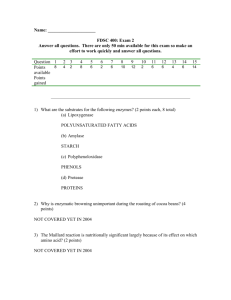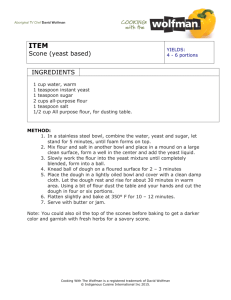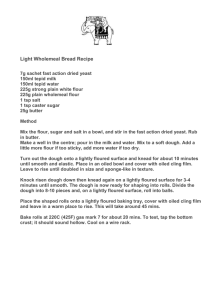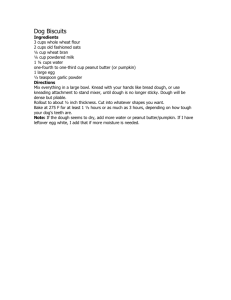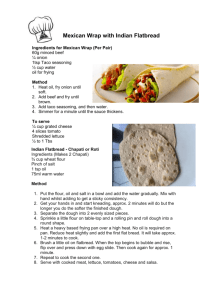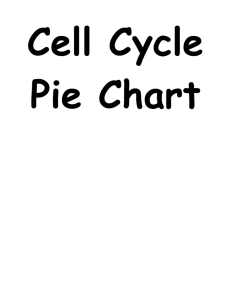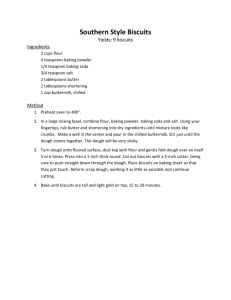PIES
advertisement
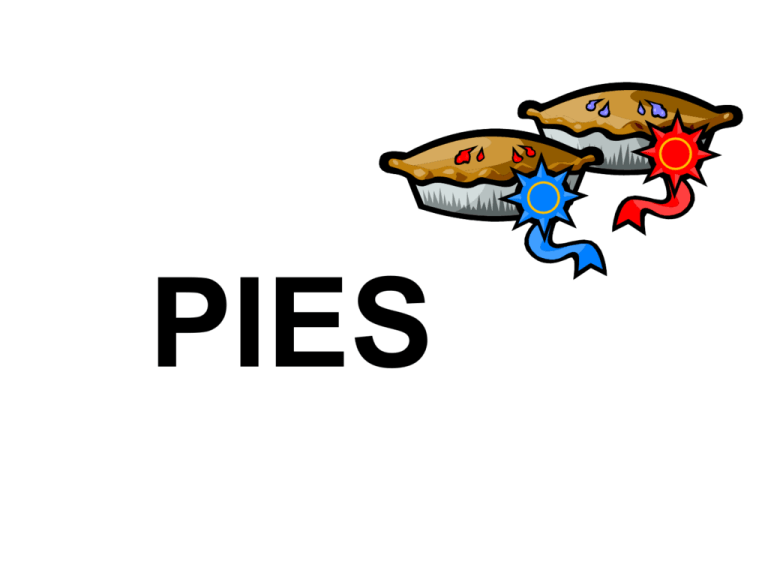
PIES PIE DOUGH • 3-2-1 Dough – Ratio refers to the weight of the three parts • Three parts flour • Two parts fat • One part water UNDERSTANDING HOW THE INGREDIENTS WORK TOGETHER • Dough is made from pastry flour because the high gluten content in bread flour absorbs most of the liquid. This makes the dough tough and rubbery. Pastry flour has enough gluten to keep the dough together so it can be rolled out. (Remember that pastry flour is between bread flour and cake flour—all purpose flour is close to pastry flour and easy to purchase.) UNDERSTANDING HOW THE INGREDIENTS WORK TOGETHER (cont.) • Butter or vegetable shortening is used to make dough. Because vegetable shortening has a high melting point (90 degrees F.-100 degrees F.) and it has a consistent quality, it is the best fat for pie dough. THE SHORTENING SHOULD BE CUT INTO THE FOUR. The size of the fat particles in the dough determines the flakiness of the pie dough. UNDERSTANDING HOW THE INGREDIENTS WORK TOGETHER (cont.) • Water or milk at 40 degrees F. or colder is added to the dough to form gluten when mixed. OVERMIXING THE DOUGH WILL MAKE IT TOUGH! The cold temperature of the water is important so that the fat in the dough firms up. The crust will fall apart if not enough liquid is added. But, the crust becomes tough if too much liquid is used, because too much gluten develops. UNDERSTANDING HOW THE INGREDIENTS WORK TOGETHER (cont.) • Salt tenderizes the gluten and enhances flavor of the dough. Be sure the salt is evenly distributed = – Dissolve the salt in the water before mixing >>or << – Sift the salt with the flour MIXING WRAP AND CHILL DUST WITH FLOUR AND PUT ON LIGHTLY FLOURED SURFACE DUST ROLLING PIN WITH FLOUR AND ROLL IN ALL DIRECTIONS ROLL IN CIRCLE LARGER THAN PIE PAN TYPES OF PIE DOUGH • FLAKY – Flour not completely blended with fat—long flake or short flake – Long-flake– the fat is about the size of walnuts— creating a flaky crust—this crust is used for pie top crust – Short-flake—the fat is about the size of peas—used for two crust pies TYPES OF PIE DOUGH • MEALY – resembles coarse cornmeal; fat is blended into the flour more completely than flaky dough; requires less water or milk; flour particles more highly coated with fat and will not absorb as much liquid; thus it will not become soggy and is good for custard and fruit pies. MIXING THE PIE DOUGH • Sift the flour • Make sure liquid is ice cold (use ice cubes) in the liquid • Cut the fat into the flour with pastry cutter • NEVER OVER MIX THE DOUGH • USE ONLY ENOUGH LIQUID TO HOLD DOUGH TOGETHER • Wrap in plastic wrap and chill before rolling--best overnight; can be frozen and defrosted overnight SHAPING THE PIE DOUGH • BE SURE DOUGH IS CHILLED—IF THE DOUGH IS TOO COLD, ALLOW IT TO SOFTEN SLIGHTLY BEFORE WORKING • SCALING—for a 9-in. top crust, use 7-oz. of dough for a 9-in. bottom crust, use 8oz. of dough. Add 1 oz. to the top crust and 2 oz. to the bottom crust for each additional inch of crust diameter. SHAPING THE DOUGH • Dusting the bench and rolling pin with flour –be careful not to use too much flour because it will make the dough tough • Rolling out the dough– it should be 1/8 in. thickness all over; roll from center to edges in all directions; check occasionally to be sure it isn’t sticking to the surface (lift and turn); when finished it should be perfectly round SHAPING THE DOUGH • Panning the dough– fold in half or roll carefully around the rolling pin to lift it without breaking; be careful not to stretch the dough, press it into the sides of the pie pan; be sure no air bubbles between pan and dough SHAPING THE DOUGH • Fluting single crust pies– gives a nice finish, it is a manner of decorating the edge of the pie crust; fold under the extra dough extending beyond the edge of the pan and bring it above the pan rim, even with the rim then press thumbs together diagonally to make a ridge around the dough. SHAPING THE DOUGH • Sealing and fluting two crust pies– put bottom crust into pan—do not trim– place cold filling into pan– then place top crust on top of the filling; use a small amount of water or egg wash (beaten egg) to moisten the edge of the bottom crust and seal the two crusts together. Tuck the edge of the top crust under the bottom of the crust; then flute the crust and apply egg wash on top of crust for shiny crust. BLIND BAKING • Sometimes pie shells need to be baked before placing the filling inside the shell— this is BLIND BAKING —it is done to pies with cooked fillings or solid fillings that will not be baked in the pie crust– to blind bake after crust is in pan and fluted, DOCK (place holes with a fork) all over the bottom and sides of the crust, then weight with another pan weighted with dried beans to prevent blisters or bubbles PIE FILLINGS • • • • • Fruit Cream Custards Soft pie Chiffon pies Fruit Fillings • Can be purchased ahead of time or made on premises • The cooked juice method or the cooked fruit and juice method– the pie filling is cooked and cooled before putting into the unbaked shell and then the pie is baked at 400 -425 degrees F. until crust is even, golden brown • Uncooked fruit will have a starch to thicken fruit juice – put into unbaked shell and baked at 400425 until golden brown; cooled and fruit juice will thicken TYPES OF STARCHES • Variety of starches are used to thicken pies • Remember to always add starch to sugar before adding liquid– avoids lumps – Cornstarch – sets up a gel that allows the fillig to hold its shape when sliced – Modified starch (waxy maize) is a type of corn product used in fruit pies that will be frozen; makes a clear, soft paste instead or a gel; does not breakdown when frozen. TYPES OF STARCHES (cont.) – Tapioca or flour starches are less often used because they cloud the pie filling – Pregelatinized starch is precooked; is good to use if fruit does not need to be cooked before filling the pie shell CREAM PIE FILLINGS • Flavored pastry cream, thickened with egg custard; cornstarch thickens the cream filling • Cooked on the range and poured into prebaked pie shell • Often topped with a meringue (sugar and stiffly beaten egg whites– piled on top of filling and browned in oven) • Examples: coconut, lemon, chocolate CUSTARDS • Filling made with eggs; poured into unbaked pie shell; when baked the egg protein firms the pie • The secret is not to over cook the filling; always preheat oven to 400-425 degrees F. bake 10 minutes to set the crust, then reduce the oven temperature to 325-350 degrees F. until filling is set SOFT PIES • Similar to custard pies; also have eggs to firm the pie when baking in unbaked pie shell • Example is Pecan Pie CHIFFON PIE • Based on either cooked fruit or cream filling • Stabilized with gelatin that is added to the hot filling • When filling is cool, meringue is folded into the filling; then the filling is placed in prebaked shell and chilled BAKING PIES • Always preheat oven • For the first 10 minutes pies should be baked at 400-425 degrees to help set the bottom crust so it will not soak up the moisture in the filling and become soggy • To keep from over baking then turn oven to 325-350 to continue baking DETERMINING DONENESS • Custard or soft pies – gently shake – if no liquid shakes it is done • Pie continues to cook after removed from oven—soft centers will firm up • Can test with knife inserted in the center— comes out clean – done • For fruit pies – follow guidelines in individual recipe/formulas; crust should be golden brown STORING AND SERVING • Cool before cutting!!!!! • To prevent bacterial growth– custard and cream pies must be refrigerated • Fruit pies can be kept at room temperature • Unbaked pie shells and unbaked fruit pies can be frozen 2 months; baked fruit pie does not freeze well Slide presentation prepared by Janet Murray, 2004

